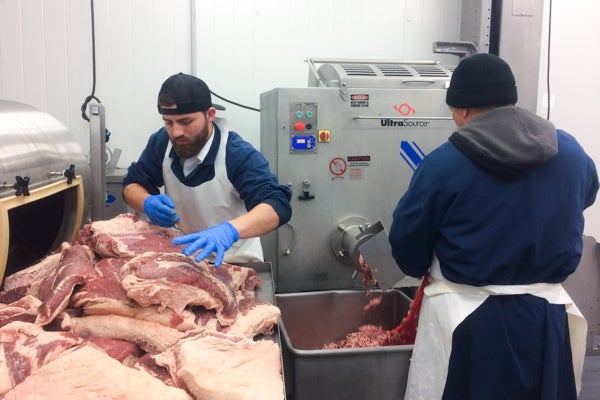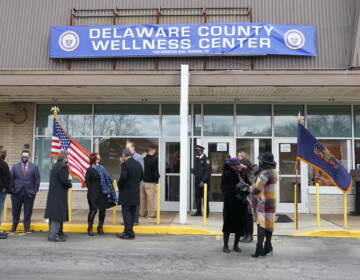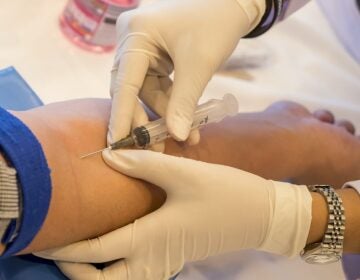How the sausage is made, safely and free of harmful bacteria
Listen 7:28
All the curing at New England Charcuterie is done in one large drying room. (Alan Yu/WHYY)
Cured meat is a big food trend in the U.S. right now, but the meat isn’t cooked with heat, so it takes a bit of work to keep the sausage free of listeria and other harmful bacteria.
Go into a high-end restaurant or bar, and it’s not uncommon to find house-cured salami, a meat board, or charcuterie on the menu. Cured meat is making a comeback in restaurants across the U.S. Aside from restaurants curing their own meat, some people also make it at home.
But making sure the meat is free of harmful bacteria can be tricky. A small factory outside of Boston uses new, quicker test to check for listeria by making samples with bad bacteria glow.
If there’s a heaven for meat lovers, it might look something like the drying room at New England Charcuterie in Boston. It’s a white room with a tall ceiling and row after row of sausages and salami and ham.
Some of these meats will hang here for two years before they’re done being dried and cured.
But, cured meat producers have to be careful about food safety, says Ted Russin, a culinary scientist at the Culinary Institute of America.
“People are talking about how they’re capturing the bounty of their materials and changing it in house, developing flavor,” Russin says. “As a scientist … I’m much more interested in how did they ensure the inherent risks in that system are managed.”
Russin starts with how cured meat is made.
“We grind the meat,” he says. “So we’re essentially pushing the surface of the meat into the center of the sausage, so now you can look at this and say the whole thing has a bacterial population distributed throughout.”
Then comes the cooking. With a steak, you might sear the surface to kill harmful bacteria using high temperature. That’s called a kill step. That doesn’t happen with cured meat; cured meat is dried, preserved with salt and other kinds of seasoning like paprika, and sometimes fermented by bacteria. Add acid or remove water to make it hard for bacteria to grow.
The owner of New England Charcuterie, Joshua Smith, says it’s almost impossible to keep all harmful bacteria out, so it’s just a matter of testing and coming up with a plan to handle them. Part of his plan is to spray an antimicrobial foam at the bottom of each door in his factory. He asks everyone to wipe their feet in it every time they pass by.

“You know the hand sanitizer for your hands?” Smith says, “Same thing, but for your feet.”
One of the big worries is listeria, which can be a serious issue in cured meat. It can cause a fever and diarrhea. In some cases, it can be deadly. It’s why the CDC says pregnant women should not eat uncooked deli meat.
Smith gets his meat tested regularly. But in the past, when he sent samples to a lab for testing, none of the meat from that batch could be sold for two days, until the tests for the harmful bacteria came back negative.
“At any given time, we can be talking about half a million dollars in product that basically is halted until we identify that everything is safe.”
Now he uses a quicker test from a food safety company called Sample6. The test from Sample6 only takes six hours, which means Smith’s half a million dollars of produce is only held up for six hours, rather than two days.
The test works by using an engineered virus that targets only listeria. Sample6 co founder Michael Koeris explains the virus will inject a bit of DNA into any living listeria cells, and the DNA makes listeria produce a specific enzyme.
“It’s related to the firefly tail-glow enzyme, so as we all see fireflies with their glowing tails and such, so will this microscopic bacterium turn itself into a mini firefly.”
Meaning you can see samples with the harmful bacteria glowing in a detection machine.
Back at New England Charcuterie, facility manager Gee Jang swabs random spaces for bacteria once a month. He puts the samples in an incubator, and if they’re glowing after six hours, that means there’s listeria.
This is also how Ben & Jerry’s and Breyers ice-cream is tested.
Now if you’re thinking that all this scientific testing seems a little out of place with a traditional food-processing method like curing meat, you’re not alone. Chef J. J. Lui at the Culinary Institute of America says some sausagemakers are grumbling about applying all this modern testing to an old art form, to which he responds with a story about Italian cheesemaking.
He recently took his students to visit a cheesemaker in the south of Italy, where cheesemakers traditionally used wooden cheese molds and wicker baskets.
“The cheese maker was using white polythene cheese molds,” Lui says. “And our students said to him, ‘Where’s the wooden molds for making cheese?’ … And the Italian cheesemaker, through a translator, said, ‘We can’t use those anymore. It’s against the law. We have to use this white plastic.'”
The white plastic can be sterilized.
Chef J. J. Lui says Italian salami makers, just like cheesemakers, are highly regulated.
“Is it taking away the old-fashioned sort of approach? Yes, but times change.”
The testing doesn’t mean the sausage tastes any different. Joshua Smith from New England Charcuterie, was in fact inspired by the idea of bringing science and tradition together.
“The pursuit of creating the old-world … ways in a technologically advanced setting was really interesting to me.”
WHYY is your source for fact-based, in-depth journalism and information. As a nonprofit organization, we rely on financial support from readers like you. Please give today.






